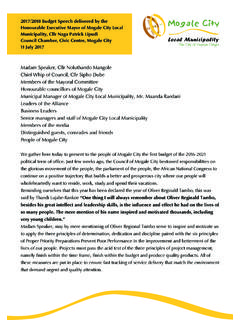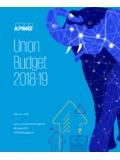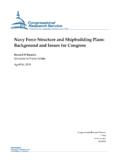Transcription of 3 Ch3 10 Feb - National Treasury
1 293 Fiscal policy In brief Government is committed to reducing the budget deficit and stabilising debt. Despite weaker GDP growth, the projected deficit for 2014/15 is per cent of GDP, just below the October 2014 estimate. Main budget non-interest expenditure has been reduced by R25 billion over the next two years compared with the 2014 budget estimate. Capital is the fastest-growing area of non-interest expenditure over the medium term, while goods and services decline in real terms. Compensation stabilises as a share of total expenditure.
2 Taxes will increase by billion in 2015/16 as a result of higher personal income tax rates, a c/litre increase in the general fuel levy and various excise duties. The Road Accident Fund fuel levy increases by 50 c/litre, generating R9 billion over the next two years. The Unemployment Insurance Fund (UIF) monthly income contribution threshold is reduced to R1 000 for one year, with no change in benefits. This will reduce the UIF surplus by about R15 billion in 2015/16. Risks to the fiscal outlook include weaker-than-expected GDP growth, an increase in the wage bill that is significantly higher than inflation and the weak balance sheets of several state-owned entities.
3 Government is actively managing these risks. Fiscal outlook n October 2014, government announced a package of measures to narrow the budget deficit, stabilise debt and begin to rebuild fiscal space. The 2015 budget implements these commitments. A combination of a lower expenditure ceiling and higher taxes will narrow the deficit from an estimated per cent of GDP in 2014/15 to per cent of GDP by 2017/18. Net debt is projected to stabilise at per cent of GDP in 2017/18. The fiscal outlook reflects downward revisions to economic growth, with forecast revenue reduced by R36 billion over the medium term compared with the projections made in October 2014.
4 These developments are partially offset by several short-term factors. A rebasing of GDP data captures an increase in the size of the economy, and has slightly reduced I budget implements government s commitments to narrow budget deficit and stabilise debt 2015 budget REVIEW 30the budget deficit and debt-to-GDP ratio. The significant decline in oil prices has reduced inflation and improved South Africa s terms of trade. Lower inflation also allows departments to purchase more goods and services without breaching the expenditure ceiling, and may facilitate a sustainable wage agreement.
5 Government is introducing additional measures to contain costs and draw on underutilised resources, sustain service delivery to the poor, and promote growth. Addressing the structural deficit Since 2012, government has pointed out that a deterioration of the economic environment would warrant a reconsideration of expenditure and revenue plans. Economic growth has been revised down for the fifth consecutive year and is likely to remain below 3 per cent over the next two years. Despite the implementation of a spending ceiling, weak economic growth has produced a persistently large budget deficit.
6 While fiscal policy has supported the economy for the past seven years, this countercyclical approach has reached its limits. The budget deficit is largely structural and cannot be reduced through a cyclical upturn in revenues. Accordingly, the 2015 budget proposals will: Reduce the expenditure ceiling by R25 billion over the next two years, compared with the 2014 budget baseline. Increase personal income tax rates and the general fuel levy, raising an additional billion in 2015/16. Strengthen budget preparation and expenditure controls to improve efficiency of resource allocation and the composition of spending.
7 Withhold additional resources for changes to personnel numbers. Ensure that the financing of state-owned companies does not increase National government s budget deficit. Given weak economic conditions, these proposals have been designed to limit the dampening effect on growth in the short term. The slowdown in spending growth is less pronounced in 2015/16, with the weight of expenditure consolidation shifted to the second year of the framework. UIF contributions have been temporarily reduced in 2015/16. Table Consolidated fiscal framework, 2011/12 2017/182011/122012/132013/142014/152015/ 162016/172017/18R billion/percentage of GDPO utcomeRevised estimate Medium-term estimates 1 1 1 1 1 1 1 1 1 1 1 1 1 1 1 1 balance.
8 National TreasuryStructural shift in fiscal policy to reduce a structural budget deficit Weight of expenditure consolidation takes place during second year of the framework CHAPTER 3: FISCAL POLICY 31 Development finance institutions plan to expand their loan books by 33 per cent over the next two years to support the economy. From 2017/18, real expenditure growth will be more closely aligned with long-term average real GDP growth. This reform will bolster fiscal sustainability, while allowing the budget to play a more predictable role in stabilising the economy.
9 Maintaining the expenditure ceiling The main budget expenditure ceiling has been in place since 2012, and remains a cornerstone of the fiscal framework. Government is on track to achieve the spending target set in the 2014 Medium Term budget Policy Statement (MTBPS) for 2014/15. Between 2003/04 and 2009/10, real expenditure growth averaged 9 per cent. Real spending growth of per cent is projected for 2015/16, declining to per cent in 2016/17. Tax policy reforms The 2015 budget proposes a one percentage point increase in marginal personal income tax rates, except for the lowest bracket, and increases in the fuel levies amounting to c/litre.
10 The proposed change in personal income tax is expected to raise billion in 2015/16. A cent increase in the general fuel levy is projected to raise an additional billion in 2015/16. In combination, these increases will reduce the budget deficit by per cent of GDP, before relief for fiscal drag. The 50 cent increase in the earmarked Road Accident Fund (RAF) fuel levy generates an additional R9 billion to help close the RAF s cash deficit. Government proposes a temporary reduction in the monthly UIF contribution threshold from the current R14 872 to R1 000, reducing the UIF s surplus by about R15 billion in 2015/16.















